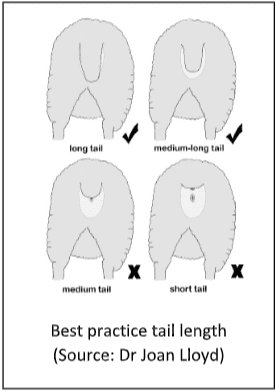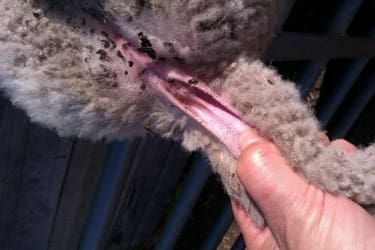 AUSTRALIAN sheep producers are still docking their lamb tails too short, despite the practice being linked to flystrike, skin cancer, arthritis prolapse, according to the results of a 2021 industry survey.
AUSTRALIAN sheep producers are still docking their lamb tails too short, despite the practice being linked to flystrike, skin cancer, arthritis prolapse, according to the results of a 2021 industry survey.
The survey conducted for Australian Wool Innovation and Meat & Livestock Australia found that among producers surveyed the average tail length for ewes was 2.5 palpable joints from the body and for wethers was slightly shorter at 2.4 joints.
AWI’s general manager, research, sheep health and welfare Bridget Peachey said this is not long enough for optimum sheep health and welfare.
“There is ample evidence that a medium-long or long tail, that is a tail docked at the third or fourth palpable joint, is better than a short tail.”
Sheep with medium-long or long tails have lower rates of flystrike, prolapse, perineal cancer and arthritis than sheep with short tails.
Sheep veterinarian Dr Joan Lloyd, whose research confirmed the link between short tails and arthritis, said it was disappointing that short tails were still prevalent in the sheep industry.
“Most arthritis in Australian sheep is caused by bacterial infection.
“The bacteria enter the sheep’s bloodstream via a wound. It can occur through any skin tear, but short tail docking is especially problematic,” Dr Lloyd said.
“When tails are docked too short, more muscle and tissue is involved.
“The wound takes longer to heal, which means it has more chance of becoming infected. One of the consequences of infection is arthritis/polyarthritis, which occurs when bacteria spread through the blood to the joints,” he said.

The correct length for docking tails, at the caudal fold. Image – Agriculture Victoria.
Dr Lloyd conducted extensive post-mortem examination of sheep and found rates of arthritis/polyarthritis are likely to be more common in lambs in southern Australia than suggested by abattoir surveillance data, with an average of 2 percent of carcases affected within affected lines.
“Arthritis is a serious sheep health and welfare concern from short tail docking, but it is not the only issue with the practice.
“The damage to muscle and other tissues means sheep with short tails are unable to lift their tails to defecate,” she said.
“In ewes, this also applies to urinating.
“This means short tails tend to lead to higher dag formation and, in ewes, more urine staining,” Dr Lloyd said.
“These things in turn lead to higher rates of breech flystrike.
“It seems counter-intuitive that a short tail would cause more flystrike, but the evidence has long supported this fact.”
Dr Lloyd said research conducted in the 1930s and 40s established the link.
“The research was conducted on unmulesed sheep and is as relevant today as it was then.”
The research, conducted prior to the availability of modern flystrike prevention chemicals, reported flystrike rates in sheep with short tails as being more than double that in sheep with long tails. In long tailed sheep 13 sheep per 100 were struck, in medium tailed sheep the rate was 27 per 100 and in short-tailed sheep it was 38 strikes per 100 sheep.
Dr Lloyd said the best length to dock a sheep’s tail is in the vertebral space after the third or fourth palpable joint.
“The remaining tail should cover the vulva in a ewe and be the equivalent length in a ram or wether.
“Another good landmark is the bare area on the underside of the tail,” she said.
“The bare area on the underside of the tail should never be cut through.
“Leaving this bare area intact means the animal will be able to lift its tail to defecate and urinate.”
AWI said a shorter tail leaves the breech exposed to sunlight and can lead to cancers of the perineal region. Research conducted in the 1980s found squamous cell carcinomas present in flocks on 82pc of farms surveyed. The prevalence of cancers ranged from 0.12pc to 4pc of ewes, and increased with age. More than 3pc of ewes over five years of age were affected. Most cancers involved lesions of the vulva and led to the animal being euthanased.
Rectal prolapse is also more common in sheep with short docked tails, due to muscle damage. If sheep are coughing from pneumonia, which is common across all sheep-raising regions of Australia, they are much more likely to suffer rectal prolapse if the tail has been docked too short. Prolapse is generally fatal.
“There are many sound reasons to dock in such a way that a medium-long to long tail is created,” Dr Lloyd said. “There are no good reasons to dock it shorter than that.”
Source – AWI.

The Merino wool industry continues to breed toward Merino ewes that produce more wool while neglecting greater genetic fat. The industry is well aware that greater genetic fat saves lambs’ lives. The average wool cut has increased by 11 percent over the past 20 or more years while genetic fat average has remained similar over that same period. Industry is not selecting for better animal welfare outcomes. Wake up stud breeders and lead.
At Parkdale Dubbo we have been selecting for shorter tail length since 2010. The tail length of a sheep is the highest heritable trait of a sheep. We now have 1000 ewes not tail docked with a tail length shorter then their hocks. We could have more; however, market forces are forcing us to continue to tail dock. The shorter we get the tail, the longer the bare area underneath the tail. I agree, don’t cut bare area under tail. Our short-tailed Merino ewes — with tails shorter than their hocks to a quarter length of traditional Merinos — are more fertile, better survivors in drought times, better converters of feed to growth and have less wool on points. They also produce more “wool length” in body wool, at 19 microns, generating 25 percent more $’s per kg greasy at public auction when sold as non-mulesed wool with an accreditation scheme. They also have more lambs; 180pc weaned. We have invited the chief of DPI NSW’s animal welfare division to inspect our sheep. The head of the animal welfare division of DPI would like to come to see what we have achieved; however, someone is stopping her to learn more of what we have achieved.
Government is supporting bad animal welfare outcomes. At Parkdale, we will be continuing to develop our short-tailed Merinos despite NSW DPI not wanting to improve animal welfare outcomes.
We ceased mulseing in 2008 and left the tails long. The long woolly tail was difficult for the shearers at crutching and shearing. The following year we went shorter like we would for crossbred lambs. I was very conscious of avoiding any cancer of the vulva like I had seen in the 1980s. The woolly tail protects the vulva from the sun. Over the last 15 years we have marked on average 11,000 Merino lambs per annum. We have not had any increase in prolapses; if anything maybe less. I estimate about 6 to 7 per annum. I have never stopped being a very keen observer of the correlation between tail length and urine stain. My recent experience has been different to the research results from many years ago. I would appreciate the opportunity to discuss this with Dr Lloyd.
Regards
Paul O’Connor
Oxton Park
Harden
Gday Paul. We started selecting for shorter tails in Merinos in 2010. No problems. The tail length of a sheep is the highest heritable trait of a sheep. We have 1000-plus Merino ewes with tail lengths above hocks and shorter, and they are not mulesed nor tail-docked. No flies, no dags, 19 micron wool and 180 percent lambs weaned. Happy days.